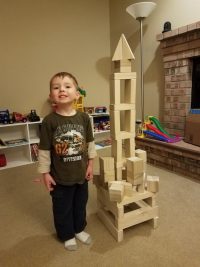 Tyla found some big wooden blocks and thought it might be fun for Elijah’s Christmas list. I balked at the $130 price tag and said “That’s ridiculous. I could build that for $30.” I now suspect that I fell right into her trap. Well played.
Tyla found some big wooden blocks and thought it might be fun for Elijah’s Christmas list. I balked at the $130 price tag and said “That’s ridiculous. I could build that for $30.” I now suspect that I fell right into her trap. Well played.
I found a “unit block” standard size of wood blocks that dates back to the early 1900s. That seemed good enough for me. As that Wikipedia link will tell you, “A unit block is 5.5 inches long, 2.75 inches wide, and 1.375 inches thick.” I used that as my base and made a couple variations on that block size. Figuring out how much wood to buy turned into a bit of a mind bender, but I ended up with the following block dimensions: 4x2x1, 2x2x2, 2x2x1 and 8x2x1 (where 1 = 1.375″).
I wanted to use cheap wood but I decided to get poplar from the wood dealer instead of using pine from Home Depot. The prices are about the same, but the poplar is a lot more stable than the wet/warped pine boards at Home Depot. I bought a lot of 6/4 (1.5″ thick) wood for most of the blocks and then a couple feet of 12/4 (3″ thick) for the cubes.
After doing this project, I actually recommend it if you are just getting started with milling your own lumber. Getting all of the blocks to be exactly the same size is a great challenge.
That part went pretty quickly and then it was a LOT of time at the sander. I already have 80 grit paper for my stationary belt sander, but I also picked up 150 grit. That sped up the process quite a bit.
If I ever do this again, I’ll do a couple things differently:
- If I was really shooting for those exact final dimensions as specified in the standard, I should have made the blocks SLIGHTLY thicker when I was cutting them to account for the losses during sanding. Poplar is pretty soft wood so it sands easily.
- I ran everything through a round over bit between cutting the blocks and sanding them. That was a waste of time as the sanding removed most of the roundover. I should have either just done it by hand with the sander or maybe used the roundover bit at the very end (with more touchup sanding on the edges after the router bit was done.)
Because I cut things a little too closely when trying to figure out which boards would give me the least amount of waste, I didn’t end up with as many blocks as I planned, but Elijah couldn’t care less. He loves these and they’ve been getting regular use.
